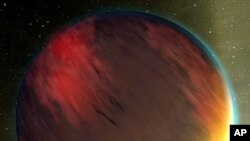U.S.-based astronomers say they have discovered the darkest alien world currently known to science, locked in tight orbit around a star 750 light years from Earth.
Scientists from the Harvard-Smithsonian Center for Astrophysics (CFA) say the enormous gas planet, known as a "hot Jupiter," reflects less than one percent of the light from its star. Some experts say the oddball world is darker than coal.
Scientists widely agree such planets - as large as Jupiter and hot in temperature - orbit close to their parent stars, but share certain characteristics that make them dark. Even so, the astronomers say science cannot fully explain why the planet they observed is so extraordinarily dark.
The exoplanet - the term for a planet outside Earth's solar system - is only about 5 million kilometers from its star, which raises temperatures there to more than 1,000 degrees Celsius, hot enough to melt gold or copper. The Harvard and Smithsonian researchers say that heat prevents formation of reflective ammonia clouds, such as those blanketing the upper atmosphere of Jupiter, the second brightest planet in our solar system.
Earth is about 30 times as far from its sun as the dark planet, and bright Jupiter is five or times as far from the sun as Earth.
The dark planet's atmosphere contains light-absorbing chemicals, including vaporized sodium and potassium and gaseous titanium oxide. But the Harvard and Smithsonian scientists say those also do not fully explain its extremely dark appearance.
The researchers add, however, that the mysterious "hot Jupiter" is not completely dark. It is so hot that it actually radiates a faint red glow, like a burning ember.
Astronomers first detected the dark planet in 2006, and researchers from the Center for Astrophysics have precisely plotted its brightness since then, using the U.S. space agency's Kepler space telescope, which is designed to locate distant planets.
The dark planet is known to scientists as TrES-2b. It orbits the star GSC 03549-02811, about 750 light-years from Earth in the direction of the constellation Draco.
Some information for this report was provided by AP, AFP and Reuters.














